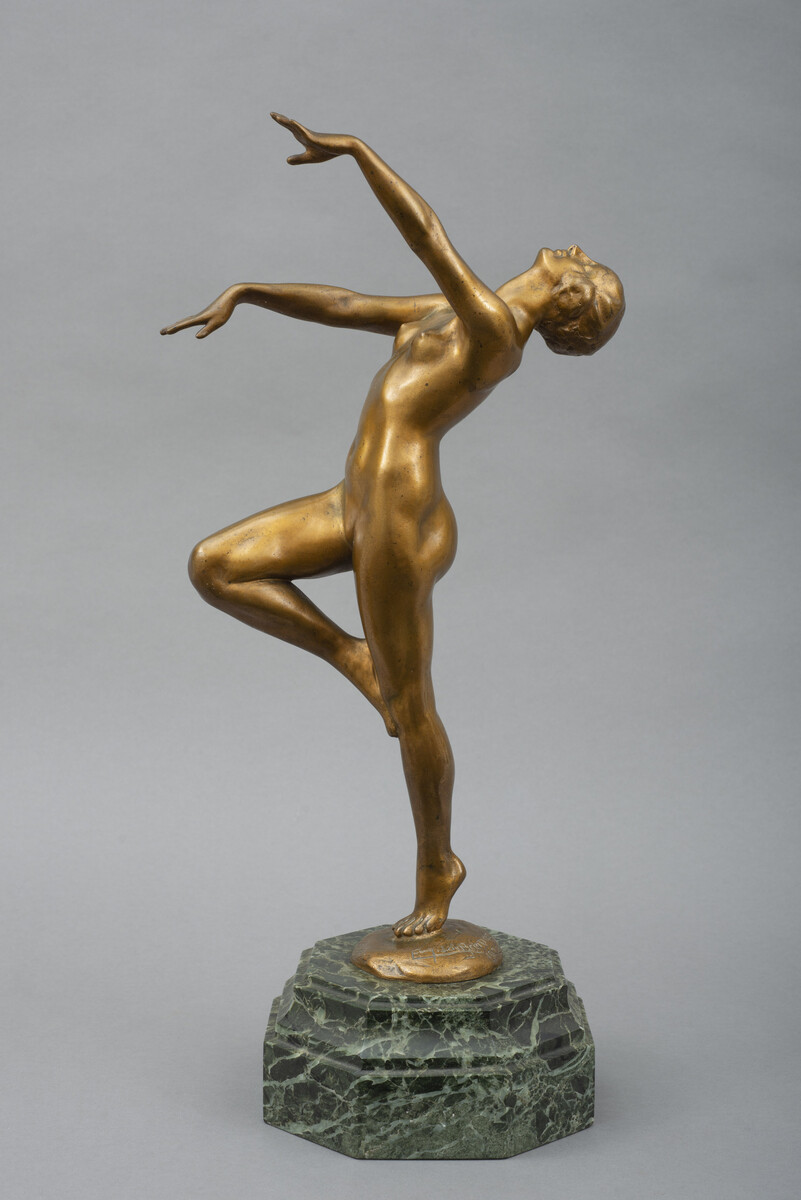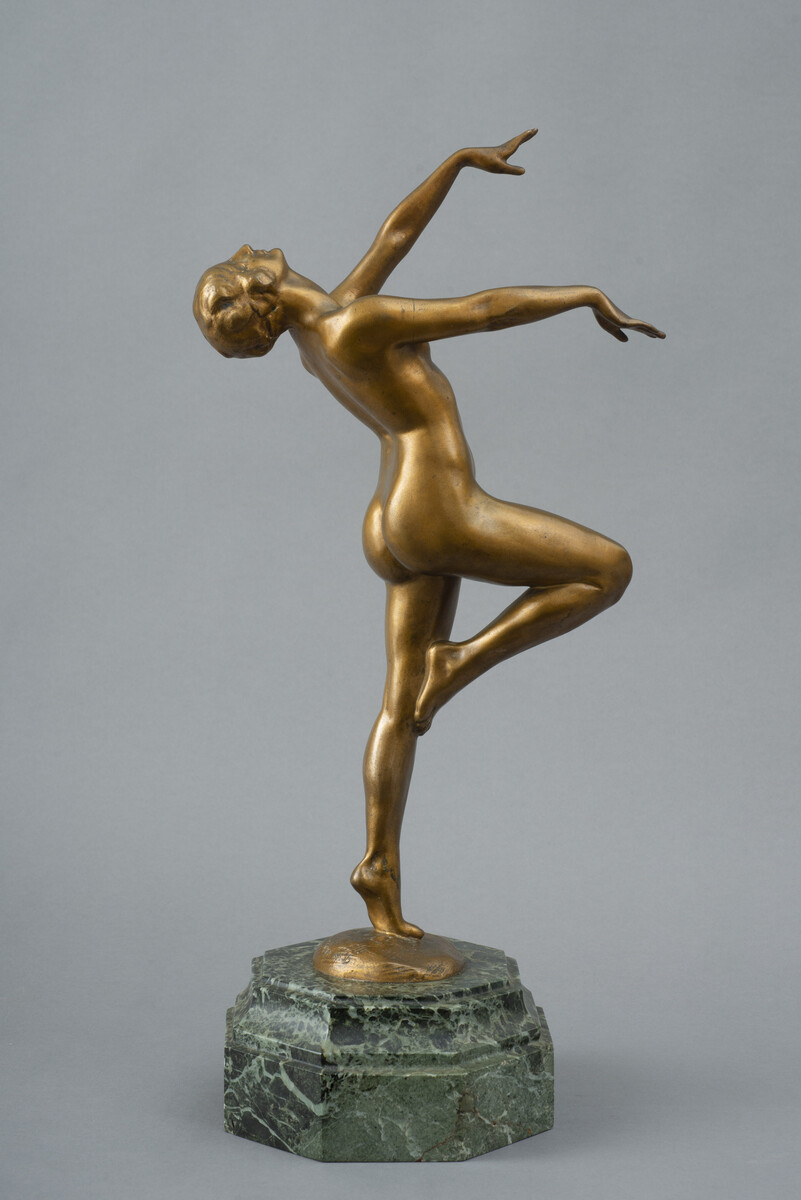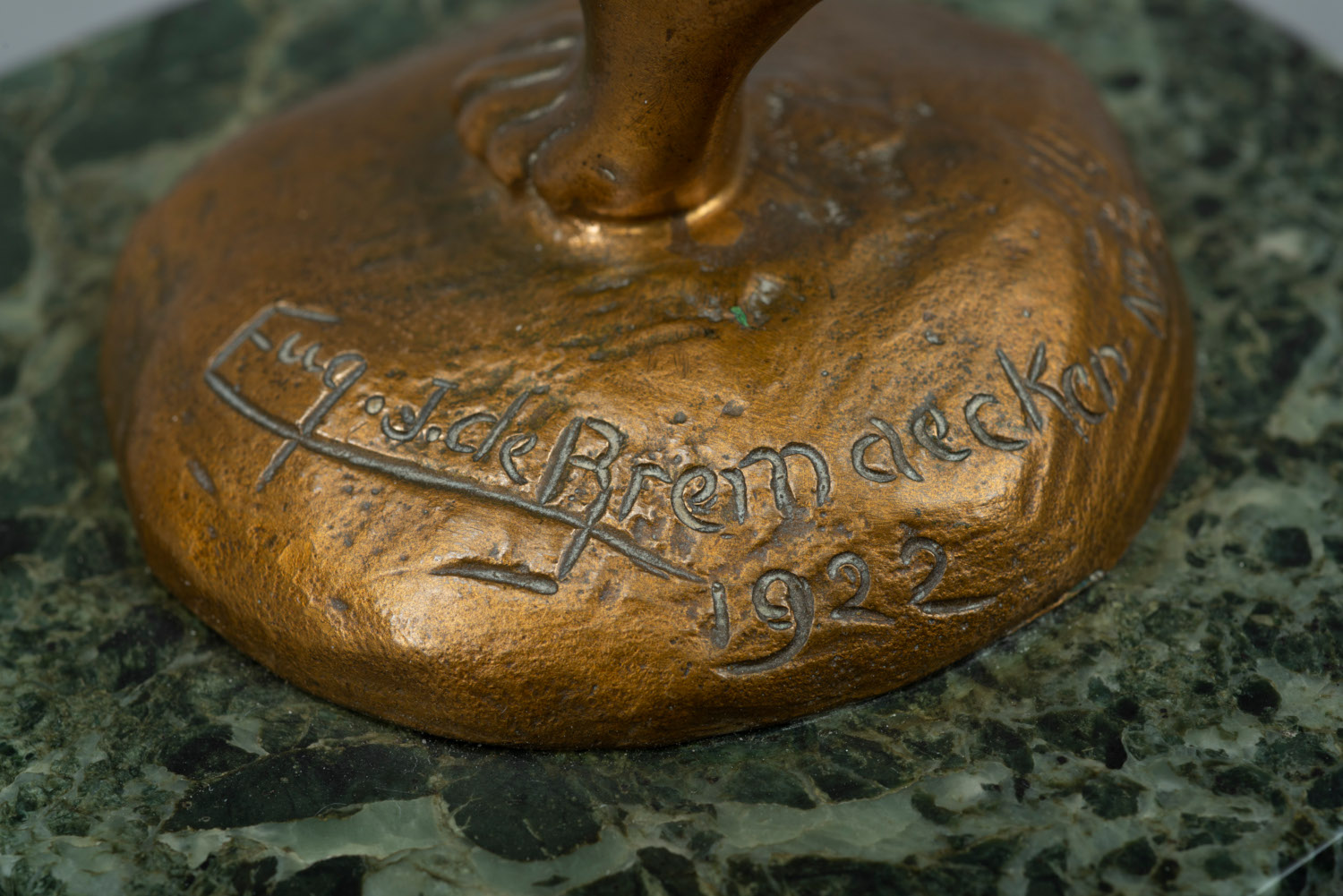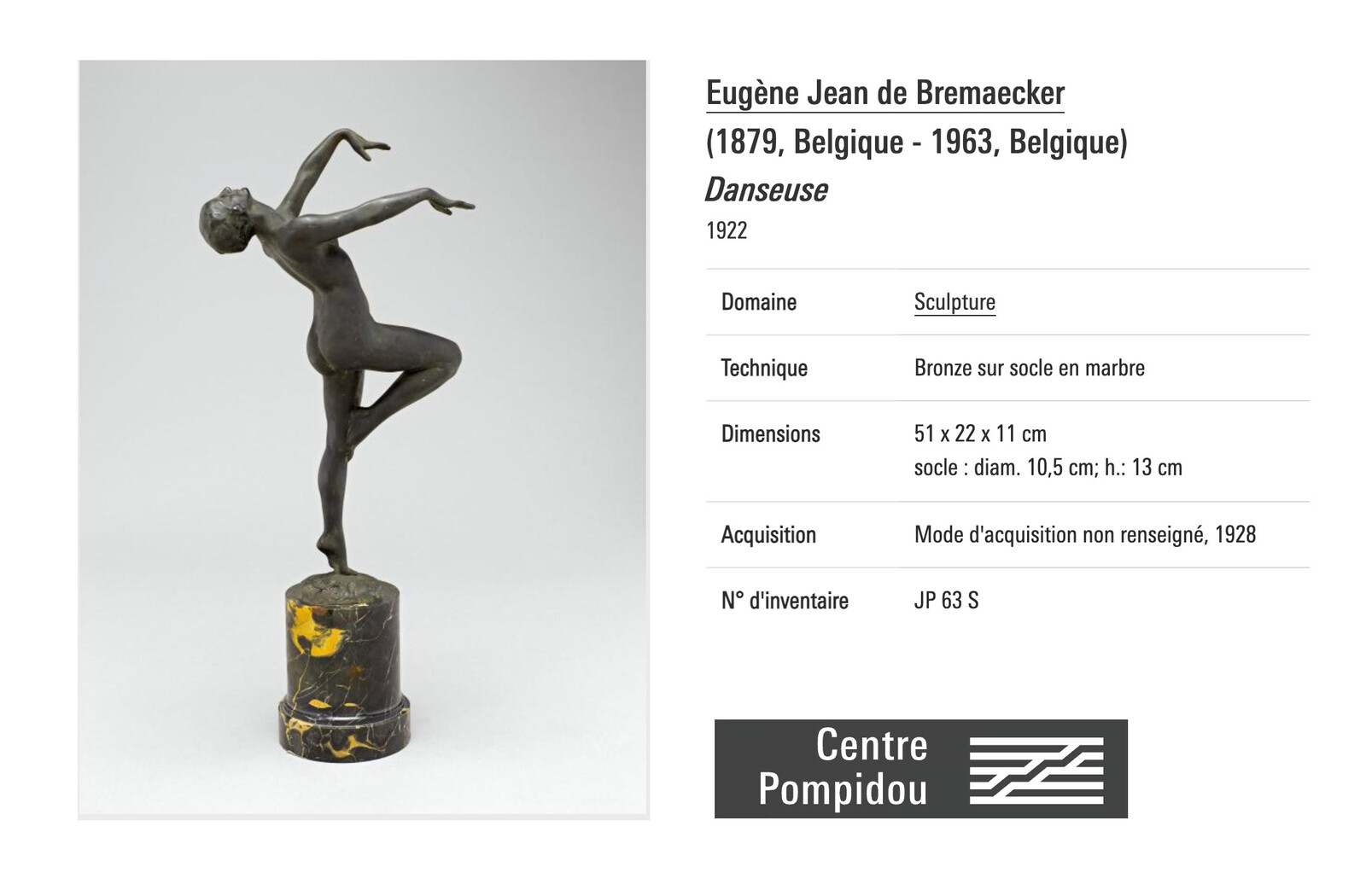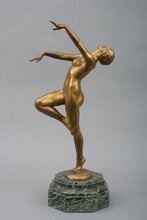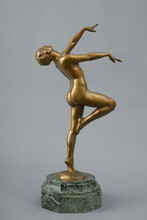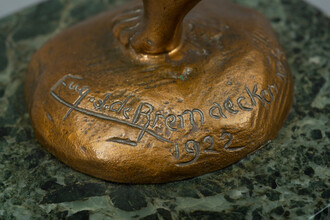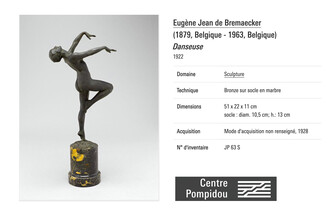Eugène J. de Bremaecker.
Born on July 14, 1879,he had an early start if we are to believe his words: "At five years old, I was already a budding sculptor! I modeled God knows how! Despite these dispositions at my young age, my father wanted me to enter the Académie de Saint-Josse to do ornamentation. I went in ... and after a month I was doing sculpture! I then went to the Academy of Brussels on the advice of Master Dillens. It was in 1900. The following year, I was received at the Salon de Bruxelles. ".
He studied with Victor Rousseau and then Julien Dillens, but he also studied other great masters on his own, he explains: "But, when you leave the Academy, what do you know? At most, the spelling! … You have to learn the trade. The study of ancient and modern is self-evident. I devoted myself to their study. I loved Carpeaux above all, the most beautiful of sculptors. I spent hours, weeks, months in the Louvre, so much so that the guards referred to me by the pretty name of Le Maniaque. Little by little, I became convinced, I worked “.Eugène de Bremaecker visits trade fairs and exhibitions, knows the works of his contemporaries such as Jef Lambeaux. He is very sensitive to the tradition of Belgian culture, including the many creators from the north of the country. He takes a pivotal position between the 19th century, from which he draws his naturalistic and particularly expressive way of working, and the first half of the 20th century, when he produces the most significant part of his work. He thus builds a bridge between two eras over the ditch of the Great War.
Besides his artistic activity, he took an early interest in photography. Barely a dozen years old, he takes pictures on Heyst beach of King Leopold II who speaks to him to encourage him in this direction. He made many photographs during the First World War. He also worked on improving wireless telegraphy, notably with Marconi at Broomfield in 1904).Eugène de Bremaecker visits trade fairs and exhibitions, knows the works of his contemporaries such as Jef Lambeaux. He is very sensitive to the tradition of Belgian culture, including the many creators from the north of the country. He takes a pivotal position between the 19th century, from which he draws his naturalistic and particularly expressive way of working, and the first half of the 20th century, when he produces the most significant part of his work. He thus builds a bridge between two eras over the ditch of the Great War.
Besides his artistic activity, he took an early interest in photography. Barely a dozen years old, he takes pictures on Heyst beach of King Leopold II who speaks to him to encourage him in this direction. He made many photographs during the First World War. He also worked on improving wireless telegraphy, notably with Marconi at Broomfield in 1904).In Belgium, the Journal d'Anvers of March 30, 1928, under the title Nos sculpteurs, Eugène de Bremaecker writes:
"If the sculptor doesn’t always have it easy, he at least - when he has a thorough knowledge of his craft - the great satisfaction of producing a work that is appreciated and admired. […] The work of Eugene de Bremaecker is one that imposes itself in silence, and that we appreciate with emotion. "
Speaking of the Paris salons on May 23, 1926, the Neptune of Antwerp said: The bust of Cardinal Mercier is one of the best productions of Eugene de Bremaecker; the torso is draped in the picturesque fashion of seventeenth-century French effigies, […] which highlights the life breathed by the bony and voluntary mask of the ascetic prelate. ".
The journal of Bruges and the province was certainly not stingy with compliments when Pierre Huybrechts said in his edition of March 25-26, 1928: “We bow with respect to this brilliant talent and art understands why de Bremaecker has deserved the favors of the great of the earth, and enjoys a worldwide reputation.
France will be attentive to its creations, in the Journal de la Seine on May 18, 1930, we can read from the pen of Albert Parenty: “At the Annual Salon which is held at the Grand Palais, the sculpture section is particularly well represented this year. . Many statuaries […] have sent works worthy of attention […] M. de Bremaecker, Neuilly, Malice, jolie tête and Par un beau matin, joli bust “.One can also read, on December 10, 1926, in Homme libre an article by René Barotte, under the title The great modern artists Eugène-Jean de Bremaecker statuary: “A few days ago, I visited Eugène de Bremaecker, well-known sculptor who shares his creative activity between his workshops in Neuilly and Brussels. Of his compatriots, our great friends the Belgians, de Bremaecker possesses the apparent placidity, at least for those who know him little, discuss a subject of everyday life. But as soon as you talk to him about his art as soon as he has felt a spiritual friend in you, his face blooms, his gaze takes on a particular radiance, ardor wins, he becomes lyrical without ever departing from clarity. of language he uses to show you a powerful and luminous aesthetic. While, joining the action to the word, working the block with his finger like a sketching tool to bring it to life, he revealed to me the secrets of his art, quickly the hours passed, too quickly I had to leave ... regretfully, of course , but happy to have met an artist (there are few in our time!) whose talent was at the height of thought. […] ”.It is not only in the press of Belgium and France that one speaks of his work thus, in the New York Herald of April 19, 1927, under the title Art Paris Notes in an article signed by George Bal:
"An exposition was opened on Friday at Trotti Galleris, place Vendôme, of the works of Eugène de Bremaecker, a Belgian sculptor, who, by numerous busts of well-know persons and and by his imaginative figures, proves that he is an artist , of great talent. I noted at once bust of Prince Léopold of Belgium and those of Cardinal Mercier, Baron Gaiffier d´Hestoy, Belgian Ambassador in Paris, and many other political personalities which indicate wath a great knowledge of the art of portraiture their author possesses. As for the varied works of this artist they are those of Amfortas from “Parsifal”, full of an expression of human grieso intense and profound. This important figure was executed from sittings by M. Rouard, of the opéra. I noticed also an interesting “Salomé”, in bronze and “Méditation”, a figure of an adolescent in plaster as being among the most important of interesting exposition. ”
Until his last days Eugene de Bremaecker lived, for the art in which he believed, to which he devoted all his passion and enthusiasm. After having had workshops in the Paris region (Neuilly, rue Jacques Dulud) and in Brussels (avenue Longchamp, now avenue Winston Churchill), he spent the last years of his life in Schaerbeek where he had his workshop.
He died on January 18, 1963 in Ixelles hospital.Works
He is best known today for his official busts and dancers. The official bust of the King of the Belgians Albert I, visible for example at the Bellevue museum on the Place des Palais in Brussels, or his dancers. It is therefore not surprising that he was recognized very early on by the European intelligentsia, he made, among others, the King Edward VIII medal. He was appointed at that time a corresponding member of the Royal Society of Arts in London.
This bronze sculpture is signed: "Eug. J. de Bremaecker"
Numbered: "N°3"
Dated: "1922"
Dimension: Total Height: 47cm. (Marble base: 7 cm, sculpture: 40 cm)
Very fine, original quality.
A similar example in the Museum: Centre Pompidou.
Literature: Beeldhouwkunst in België, Engelen-Marx, page 360-364
